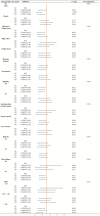The relationship between CALLY index and stroke in hypertensive patients: insights from NHANES
- PMID: 40491586
- PMCID: PMC12146181
- DOI: 10.3389/fnut.2025.1592641
The relationship between CALLY index and stroke in hypertensive patients: insights from NHANES
Abstract
Background: At present, stroke ranks as the third leading cause of mortality, and hypertension is a major risk factor for stroke. Complementary assessment of inflammation level, immunity, and nutritional status is now possible using the newly developed C-reactive protein-albumin-lymphocyte (CALLY) index biomarker. One key concern in this study is that its correlation with the risk of stroke in individuals with hypertensiveness.
Methods: In this study, we used cross-sectional analyses from the National Health and Nutrition Examination Survey (NHANES) database through 2003 to 2010. The CALLY index was calculated by albumin and lymphocytes divided by C-reactive protein (CRP). In order to further analysis, the CALLY index was log-transformed to increase data normality and lessen the impact of extreme values on the analytical findings. We investigated the odds ratios and confidence intervals of the ln CALLY index and its components in connection to stroke in people with hypertension. A weighted multivariable logistic regression model was carried out. Additionally, we used weighted restricted cubic splines (RCS) and subgroup analyses to further examine the association between the CALLY index and stroke prevalence in hypertensive individuals.
Results: This study included 8,146 hypertensive participants, of whom 616 hypertensive participants had a stroke. In unadjusted modeling, we found a 39% reduction in the incidence of stroke in the hypertensive population in the highest ln CALLY quartile group (OR 0.61, 95% CI 0.46-0.82), and the negative association remained significant after adjustment for confounders. While ALB showed a robust protective impact in hypertensive people, with greater ALB levels linked to a decreased risk of stroke (OR 0.50, 95% CI 0.37-0.68), we also discovered a positive correlation between CRP and stroke risk (OR 1.13, 95% CI 1.04-1.22). A substantial correlation between the ln CALLY index and stroke risk in hypertensive individuals was also validated by subgroup analysis. The ln CALLY index and stroke risk in this sample also showed a strong linear negative connection, according to weighted restricted cubic spline (RCS) analysis.
Conclusion: There is a significant negative association between the CALLY index and stroke risk in hypertensive patients in the U.S. adults. The CALLY index may be a potential indicator for early identification of individuals at higher risk of stroke in hypertensive patients and provide potential for clinical intervention.
Keywords: Cally index; NHANES; inflammation; nutritional; stroke.
Copyright © 2025 Fan, Qing, Zhao, Luo, Li, Tan and Liu.
Conflict of interest statement
The authors declare that the research was conducted in the absence of any commercial or financial relationships that could be construed as a potential conflict of interest.
Figures








References
-
- GBD 2021 Causes of Death Collaborators . Global burden of 288 causes of death and life expectancy decomposition in 204 countries and territories and 811 subnational locations, 1990–2021: a systematic analysis for the Global Burden of Disease Study 2021. Lancet. (2024) 403:2100–32. doi: 10.1016/S0140-6736(24)00367-2, PMID: - DOI - PMC - PubMed
-
- Powers WJ, Rabinstein AA, Ackerson T, Adeoye OM, Bambakidis NC, Becker K, et al. . 2018 guidelines for the early management of patients with acute ischemic stroke: a guideline for healthcare professionals from the American Heart Association/American Stroke Association. Stroke. (2018) 49:e46–e110. doi: 10.1161/STR.0000000000000158, PMID: - DOI - PubMed
-
- Pandian JD, Sylaja PN, Lackland DT, Babu V, Kumar Paramasivan N, Sebastian I, et al. . World stroke organization and world hypertension league position statement on hypertension control strategies in prevention and management of stroke. Int J Stroke. (2025) 20:151–65. doi: 10.1177/17474930241309276 - DOI - PubMed
LinkOut - more resources
Full Text Sources
Research Materials
Miscellaneous

